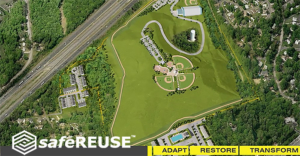ites previously utilized as solid waste landfills or coal ash ponds need not remain permanent blights on the environment. Through land reuse, such areas can often be converted into spaces that offer greater value and utility than their original condition.
Nonetheless, costs remain a significant factor in determining the feasibility of land reuse projects. One of the primary expenses involves the appropriate disposal of remediated contaminated materials commonly generated at the outset of these initiatives.
Integrating these two environmental aspects of the land reuse project can generate significant cost savings . By incorporating remediated materials into project structures—such as flood control features, stability berms, or other engineered structural fills—the need for expensive off-site disposal is minimized. As a result, project owners may be able to commence land reuse initiatives more promptly, without waiting for additional funding.

Do you have the RIGHT TOOLS to manage your land reuse project?
EnCAP-IT’s tools focus on Encapsulated Mechanically Stabilized Earthen (eMSE) Structures. These tools are designed to offer three specific advantages.
1Safety as a Key Component
Proactive Moisture Management: Within an encapsulated mechanically stabilized earthen (eMSE) system, the geomembrane liner fully encloses the structure—including the fill material—to effectively prevent stormwater intrusion and migration into the fill, as well as seepage originating from internal or external sources within the waste mass. Additionally, a toe drain collector positioned at the base of the eMSE system is employed to capture water entering the fill during the construction phase.
Key aspect of eMSE structures: encapsulation and proactive control of moisture by “wrapping” the eMSE fill with geomembrane, reducing a major cause of structural failure.
2Flexible Use of Materials and Configuration Improve Functionality
Flexible and Scalable: In an eMSE system application, the same protective measures employed by the waste industry to isolate waste are utilized. In contrast to traditional MSE approaches, where construction costs can undermine the structural design efficiency and, consequently, the project’s economic viability, the eMSE system leverages alternative fill materials to increase flexibility in design configurations. This adaptability serves to enhance overall project economics.
Key aspect of eMSE structures: encapsulation provides flexibility via economized design elements that are configured to address specific site requirements.
3Flexible Use of Materials Improve Savings
Material Procurement: Within the context of eMSE system applications, offering flexibility in the selection of structural fill—by utilizing recycled materials with low contamination levels instead of relying solely on costly natural resources—creates significant opportunities. The principal motivation for converting an existing waste stream into a beneficial use material stream lies in its substantial economic advantages.
Key aspect of eMSE structures: material markets that could not be previously pursued (in both cases: onsite or offsite materials) can become a new source, benefiting the project.
Creativity, ingenuity, and innovation is the answer.

Pull-Back Bi-Directional Hydrostatic Barrier
An eMSE berm (safeBERM®) can create a barrier that prevents intermittent, recurring, or sustained hydraulic connection between impacted areas and aquifer.

Strengthening a Sloped Structure
An eMSE berm (safeBERM®) can be used to strengthen an existing Berm, Basin, Levee, Embankment, or the Like by constructing an adjacent eMSE structure.

Flood Control Prevention
An eMSE berm (safeBERM®) can protect facilities from river flooding caused by heavy rains.
Now is the time to address future challenges. Effective land reuse demands innovation, careful planning, and the ability to look past short-term issues in order to pursue improved long-term outcomes.
EnCAP-IT offers the necessary tools to help you achieve your goals.





